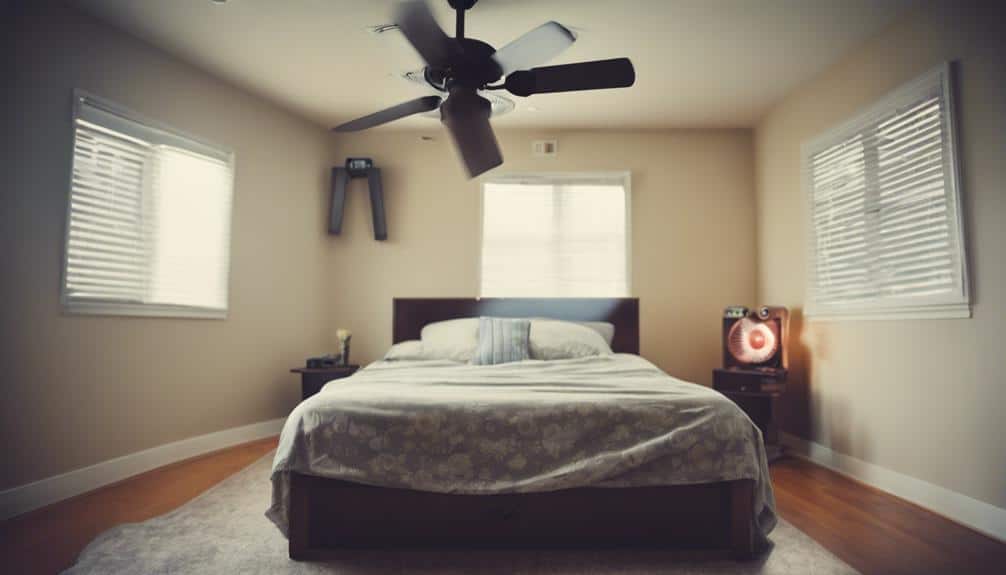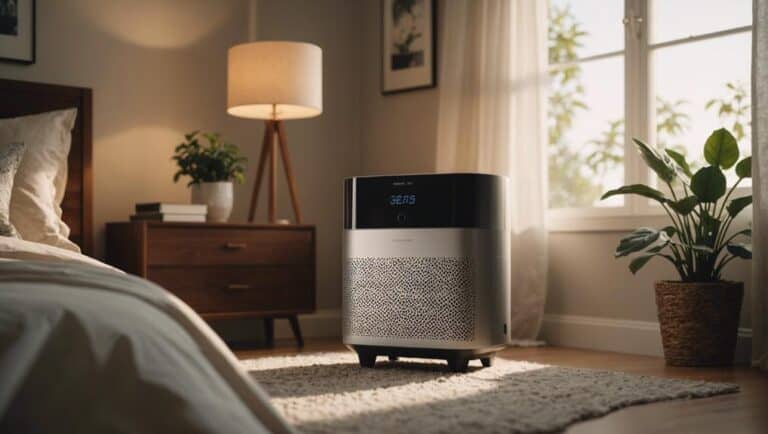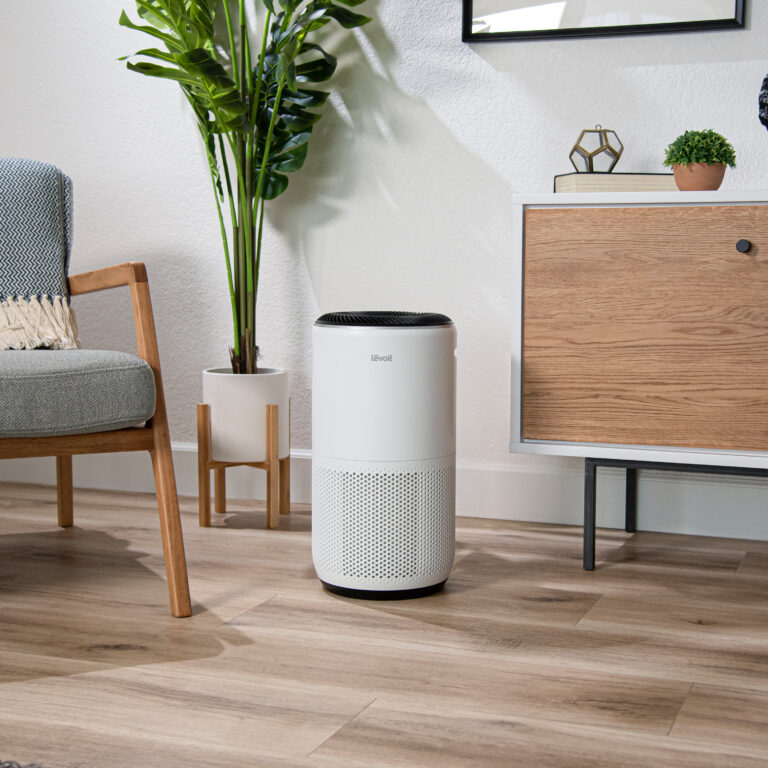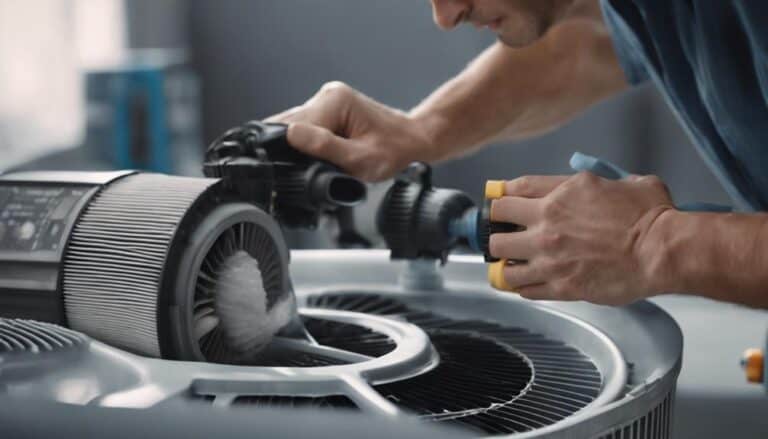10 Tips to Position Fans for a Cooler Room With AC
When it comes to positioning fans for a cooler room with AC, think of them as diligent assistants, tirelessly working to disperse the cool air throughout your space.
But, how can we make the most out of this cooling duo?
Let’s explore some strategic tips that can help maximize the efficiency of your fans and air conditioning system, ensuring a comfortable and invigorating environment to beat the summer heat.
Cross-Breeze Benefits
Creating a cross-breeze with fans optimizes room cooling efficiency by circulating air from multiple directions simultaneously. By strategically placing fans in opposite windows, the cross-breeze effect can notably cool a room by fostering a continuous flow of air throughout the space. This process accelerates cooling by swiftly displacing warm air with cooler air, creating a more comfortable environment.
Positioning fans to direct airflow across the room assures an even distribution of cool air, preventing any hot spots and maximizing comfort levels. The synergy of two fans working together not only enhances ventilation but also aids in reducing humidity levels, leading to an overall improvement in cooling efficiency.
Leveraging the power of air circulation through the creation of a cross-breeze is a simple yet effective method to cool a room efficiently and enhance the comfort of its occupants.
Optimal Fan Placement
To optimize fan effectiveness in cooling a room, strategic placement at the level of the cold air vent is important for efficient air circulation. Angling the fans upwards helps distribute cold air effectively across the room. It’s also beneficial to space out multiple fans within the room to maximize airflow and cooling. Ceiling fans, when strategically placed, can enhance overall air circulation. Additionally, window fans play a vital role in exhausting warm air and bringing in cooler air from outside, enhancing cooling efficiency.
| Fan Type | Placement |
|---|---|
| Ceiling Fan | Strategically placed |
| Window Fans | Exhaust warm air, intake cool air |
| Box Fans | Optimal spacing |
| Tower Fans | Distribute cold air effectively |
Utilizing Box Fans Effectively
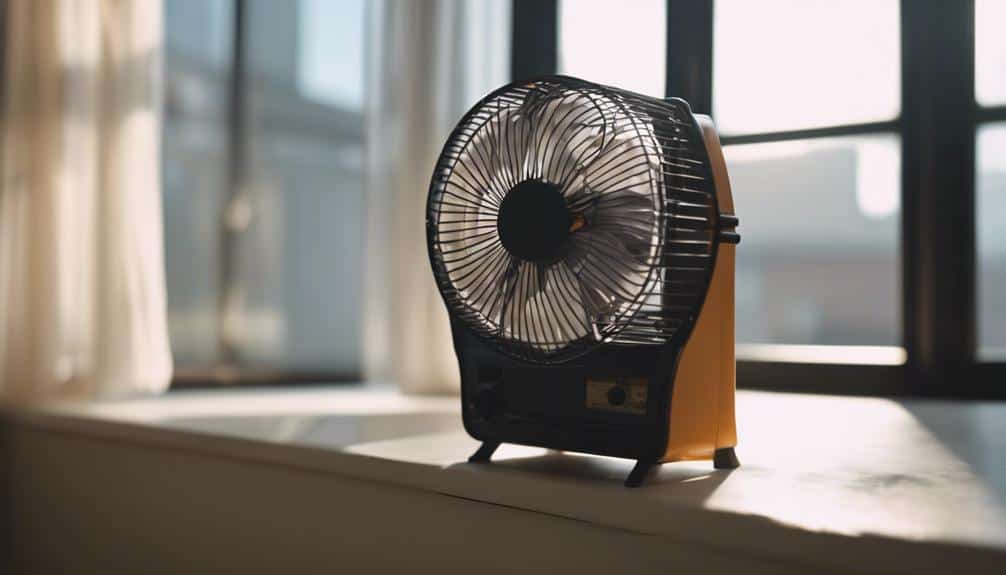
To effectively utilize box fans:
- Point them directly at occupants to maximize cooling efficiency.
- Maintain best airflow by regularly cleaning the fans.
- Strategically position them to circulate cool air throughout the room.
Use box fans in conjunction with A/C units for cost-effective cooling. Consider placing them near windows to help exhaust hot air and draw in cooler air. Adjust the speed settings of box fans based on the room size and desired cooling intensity for best results.
Fan Placement Tips
Placing box fans strategically around a room can optimize airflow and enhance cooling efficiency. When utilizing box fans effectively, consider the following tips:
- Position box fans facing occupants to directly cool them.
- Place box fans near windows to draw in fresh air and circulate it throughout the room.
- Use multiple box fans strategically to create a cross-breeze effect for efficient cooling.
- Avoid obstructing box fans with furniture or curtains to maximize air circulation.
Airflow Direction
When optimizing airflow with box fans, position them strategically to direct air towards the room’s center for efficient circulation. By placing box fans to blow air towards the ceiling, you can help circulate the cool air more effectively throughout the room. This method aids in pushing the cool air from the floor upwards, ensuring even distribution and preventing any pockets of warm air from forming.
Additionally, strategically placing box fans can create a cross-breeze effect when combined with your AC unit, further enhancing the cooling effect. Remember to keep the path clear for the airflow and avoid blocking the fans with furniture or curtains to maximize their efficiency in circulating cold air.
Speed Settings
Adjusting the speed settings on box fans can greatly impact the cooling efficiency of a room. Higher speeds produce a stronger cooling effect, while lower speeds provide a gentler breeze for comfort.
When utilizing box fans effectively, consider the following:
- Varied Speed Settings: Box fans offer various speed options to adjust airflow intensity.
- Strong Cooling Effect: Higher fan speeds can enhance the cooling effect in the room.
- Gentle Breeze: Lower fan speeds help maintain a comfortable airflow without making the room too cold.
- Best Cooling Level: Experiment with different speed settings to find the best balance between cooling efficiency and personal comfort.
Ceiling Fan Direction
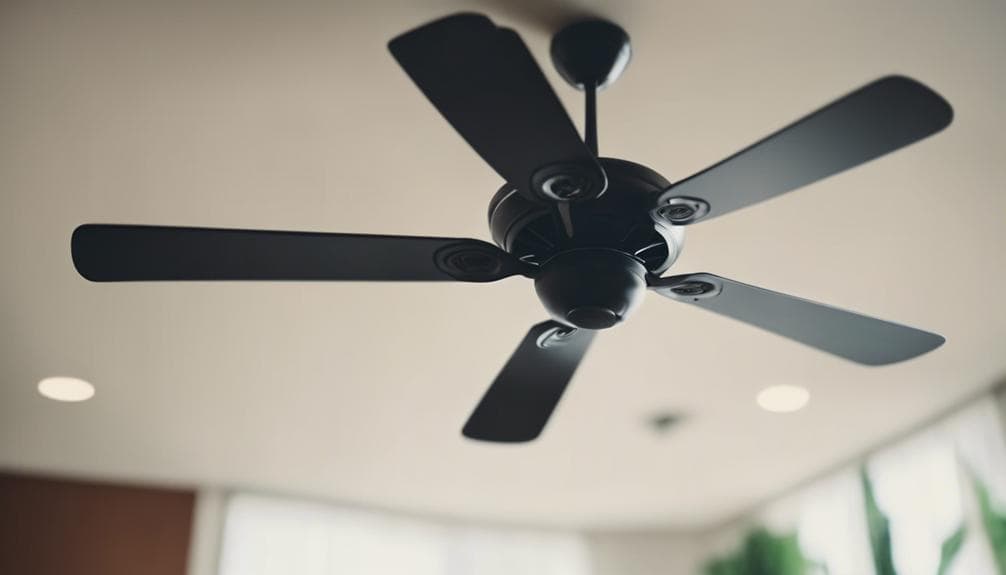
When considering ceiling fan direction, it’s important to understand the benefits of both clockwise and counterclockwise rotation.
Adjusting the fan angle can optimize air circulation to maximize cooling or heating efficiency.
Finding the best speed setting for your ceiling fan can further enhance its ability to regulate room temperature effectively.
Clockwise or Counterclockwise?
To optimize cooling efficiency, make sure your ceiling fan rotates counterclockwise during the summer months. This direction helps push cooler air down, creating an invigorating breeze and a wind-chill effect that can make you feel cooler. Additionally, setting your fan counterclockwise can save energy by reducing the need for constant air conditioning. Here’s why counterclockwise rotation is beneficial:
- Pushes cooler air down: Counterclockwise rotation helps circulate the cooler air in the room effectively.
- Creates a wind-chill effect: This effect enhances the perception of coolness on your skin.
- Energy-saving: By relying more on fans during warmer months, you can reduce energy consumption.
- Optimizes cooling efficiency: Understanding and utilizing the correct fan direction enhances overall cooling in your space.
Adjust Fan Angle
During the summer months, ensuring your ceiling fan is set to rotate counterclockwise is key to maximizing cooling efficiency and creating a comfortable environment in your home. When the fan rotates counterclockwise, it creates a downward airflow that produces a wind-chill effect, making you feel cooler.
This adjustment can make a room feel up to 4 degrees cooler by circulating the air efficiently. By setting your fan to rotate counterclockwise, you can enhance the cooling effect of your air conditioner, allowing you to maintain a comfortable temperature while potentially reducing energy costs.
Properly adjusting the angle of your ceiling fan can greatly improve the overall cooling experience in a room when used in conjunction with your AC system.
Optimal Speed Setting
Setting the best speed for your ceiling fan rotation direction is essential for maximizing air circulation and cooling efficiency in your living space. When it comes to optimizing the speed setting of your ceiling fan for a cooler room with your air conditioner, consider the following:
- Counterclockwise Rotation: Set ceiling fans to rotate counterclockwise in summer to create a cooling breeze.
- Temperature Impact: Running ceiling fans counterclockwise can make a room feel up to 4 degrees cooler.
- Clockwise Rotation: In winter, use clockwise rotation to help redistribute warm air trapped near the ceiling.
- Enhanced Cooling: Using ceiling fans in conjunction with your AC unit can make a room feel cooler with less AC usage.
Enhancing Airflow With Fans
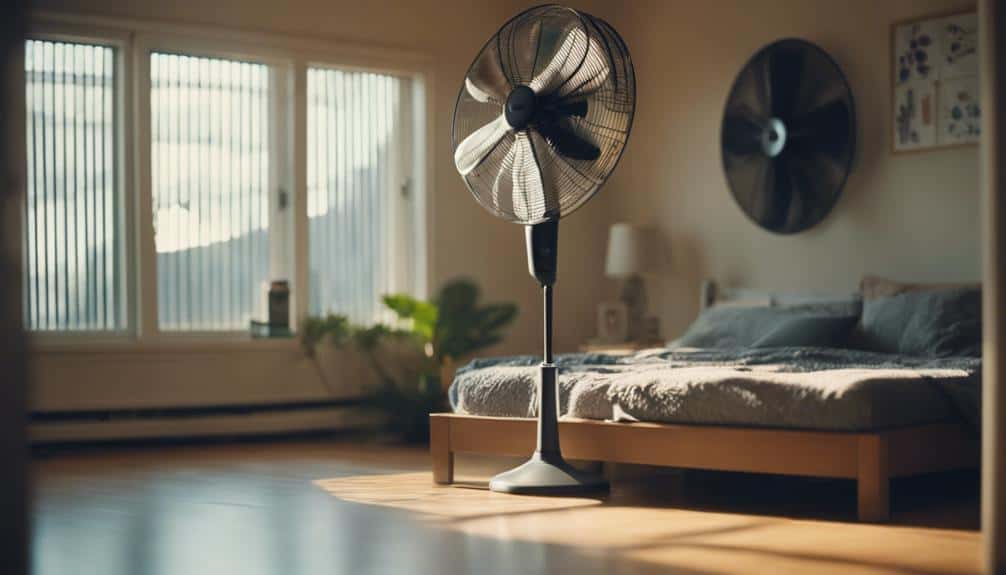
Enhancing airflow with fans involves strategically placing them near open windows to improve ventilation and circulation within a room. By positioning fans effectively, you can create a cross-breeze effect that enhances air circulation and helps cool down the space efficiently. Here is a table to illustrate how fans can be strategically placed to optimize airflow:
| Placement | Effectiveness |
|---|---|
| Near open windows | Improves ventilation and brings in fresh air |
| Near large furniture | Helps circulate air throughout the room |
| In doorways/hallways | Facilitates airflow between rooms |
Placing fans near windows allows them to push hot air out while drawing in cooler air from outside, promoting better airflow and creating a invigorating breeze. Similarly, positioning fans strategically near large furniture pieces ensures that air is circulated effectively, preventing any stagnant hot spots in the room. Additionally, placing fans in doorways or hallways can help channel air between rooms, promoting a cooler environment throughout the space.
Combining Fans With AC
When combining fans with AC, it’s essential to contemplate strategic fan placement near AC vents to optimize air circulation.
By pushing cold air away from the AC unit towards the center of the room, fans can assist in maintaining a consistent temperature throughout the space.
This approach not only enhances cooling efficiency but also aids in reducing energy consumption, making it a practical method for cooling rooms effectively.
Fan Placement Tips
Strategically positioning fans at the level of the cold air vent is important for effectively circulating cool air when using an AC system. When combining fans with AC, consider the following fan placement tips:
- Position fans throughout the room at the level of the cold air vent to circulate cool air efficiently.
- Angle fans upwards to aid in distributing cold air effectively in conjunction with the AC.
- Place multiple fans strategically to guarantee even airflow and consistent cooling.
- Utilize a ceiling fan for improved air circulation when using fans alongside the AC system.
Air Circulation Strategies
To optimize air circulation and enhance cooling efficiency, strategically positioning fans at the level of the cold air vent is vital when combining fans with an AC system. Fans help distribute cold air more effectively throughout the room, ensuring a more uniform cooling experience.
Proper fan placement plays an essential role in improving air circulation, reducing the need to run the AC at very low temperatures. By strategically placing fans near the cold air vent, you can maintain a consistent and comfortable room temperature.
This combination of fans with AC not only enhances cooling but also helps in creating a more balanced airflow across different areas of the room, ultimately improving the overall cooling efficiency and comfort level.
Temperature Control Methods
Positioning fans strategically near air conditioning vents enhances cooling efficiency by effectively circulating cool air over a wider area. When combining fans with an A/C unit, consider these temperature control methods:
- Enhanced Air Circulation: Running fans near A/C vents helps circulate cool air faster, distributing it more efficiently throughout the room.
- Economical Cooling Solutions: Utilize tower fans or box fans in conjunction with the A/C to provide cost-effective cooling options.
- Maintaining Comfortable Room Temperature: Fans, when used strategically with A/C units, can help maintain a consistent and comfortable room temperature.
- Hot Air Extraction: Using window fans to pull hot air out of the house complements the cooling effect of the A/C system, aiding in overall temperature regulation.
Furniture Fan Strategy
Placing fans near large furniture pieces enhances air circulation efficiency within the room. By strategically positioning fans close to furniture, you can efficiently distribute cool air and maximize cooling benefits. This strategy helps prevent air stagnation and guarantees that the airflow isn’t obstructed by the furniture, allowing the fan to circulate air effectively.
Using furniture as a tool to enhance fan performance is a smart way to optimize air circulation and maintain a cooler room temperature. To achieve the best results, avoid placing furniture directly in front of or behind the fan, as this can disrupt the airflow and hinder the cooling process. Instead, position fans strategically near furniture to create a continuous circulation of cool air throughout the room, enhancing the overall cooling effect.
Using Wet Towels for Cooling
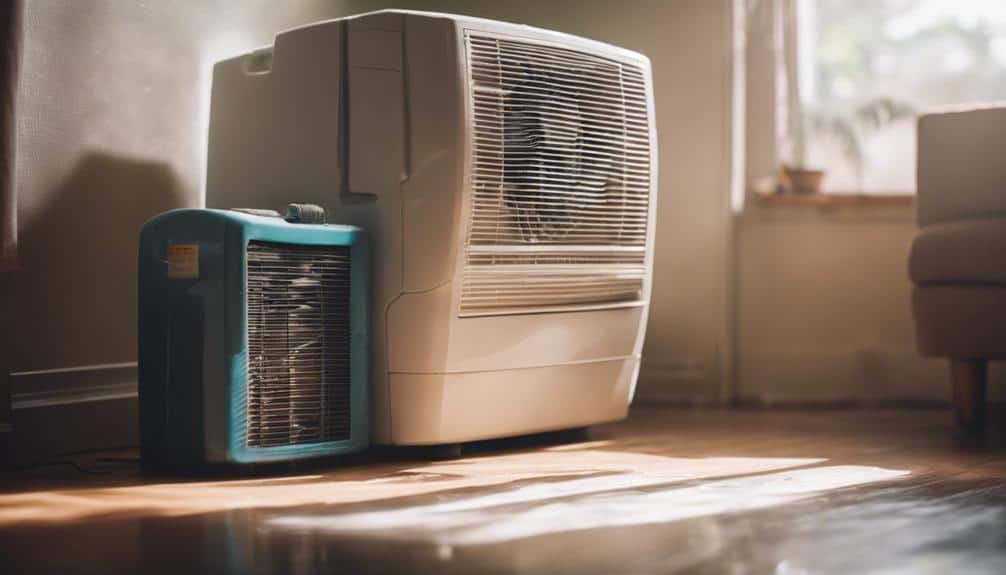
Enhancing room cooling efficiency can be achieved by utilizing wet towels strategically near fans to create a wind chill effect for additional cooling benefits. When wet towels are used in conjunction with a fan, the process of evaporation draws heat from the air, resulting in cooler air being circulated.
Here are some key points to take into account when using wet towels for cooling:
- Strategic Placement: Hang wet towels near the fan or drape them over a drying rack positioned in front of the fan to maximize the cooling effect.
- Regular Moistening: Keep the towels damp by misting them with water periodically to maintain the evaporation process and continue cooling the air.
- Air Circulation: Make sure that the fan is set to a moderate speed to help circulate the cool air generated by the wet towels effectively throughout the room.
- Room Temperature Regulation: Monitoring the room temperature while using wet towels can help gauge the effectiveness of this cooling method and make adjustments as needed to achieve the most comfortable levels.
Ice Placement for Extra Coolness
When augmenting room cooling methods, incorporating ice near a fan can greatly boost the overall cooling efficiency by leveraging the chilling properties of the ice to enhance the airflow. Placing a bowl of ice in front of a fan can create a cooling effect by circulating cold air throughout the room. The ice helps lower the room temperature rapidly when combined with a fan, allowing for a quick cooling process. As the ice melts, it adds humidity to the air, making it feel cooler as the fan blows the cold air around. This method is a cost-effective way to increase the cooling efficiency in a room, especially during hot days. Below is a table summarizing the benefits of using ice near fans to cool a room effectively:
| Benefit | Description |
|---|---|
| Quick Cooling | Ice helps lower room temperature rapidly when used with a fan. |
| Enhanced Airflow | Circulates cold air throughout the room for increased comfort. |
| Cost-effective | Using ice near a fan is an affordable way to boost cooling efficiency. |
| Humidity Addition | Melting ice adds humidity, making the air feel cooler as the fan circulates the cold air. |
| Efficient Operation | Accelerates the cooling process and reduces the room temperature quickly. |
Fan Maintenance Tips
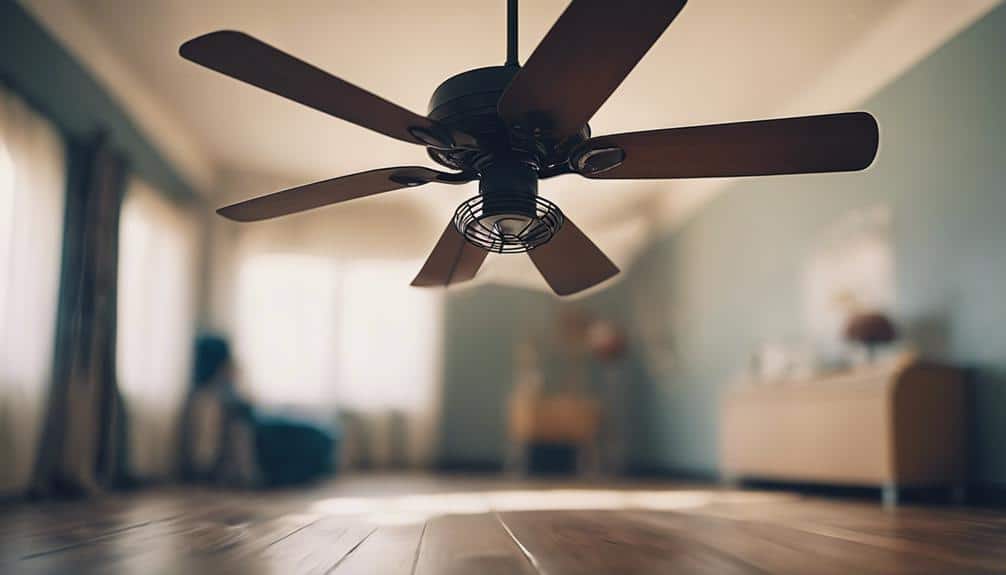
Regularly cleaning fans is essential for maintaining peak airflow and performance. Neglecting fan maintenance can lead to reduced efficiency due to dust and debris buildup over time. To guarantee your fans operate at their best, follow these maintenance tips:
- Clean Blades: Check fan blades regularly for dust accumulation. Use a damp cloth or a small brush to gently clean the blades. Removing dust guarantees peak airflow and prevents particles from circulating in the room.
- Lubricate Bearings: Refer to the manufacturer’s recommendations for lubricating fan motor bearings. Proper lubrication prevents the bearings from overheating and helps maintain smooth operation. This step can extend the lifespan of your fan.
- Inspect Cords and Plugs: Periodically examine fan cords and plugs for any signs of damage or wear. Frayed cords or damaged plugs can pose safety hazards. Replace any compromised components promptly to guarantee safe operation.
- Schedule Maintenance: Establish a regular maintenance schedule for your fans. Consistent upkeep will prolong the life of your fans and keep them running efficiently.
Conclusion
To conclude, positioning fans strategically near A/C vents and utilizing different types of fans can effectively cool a room faster and create a more even temperature distribution.
By following these tips, you can maximize the cooling benefits of your A/C unit and fans, leading to a more comfortable and energy-efficient living space.
Remember to maintain your fans regularly to guarantee peak performance and cooling efficiency.
Stay cool and enjoy the benefits of a well-ventilated room!
